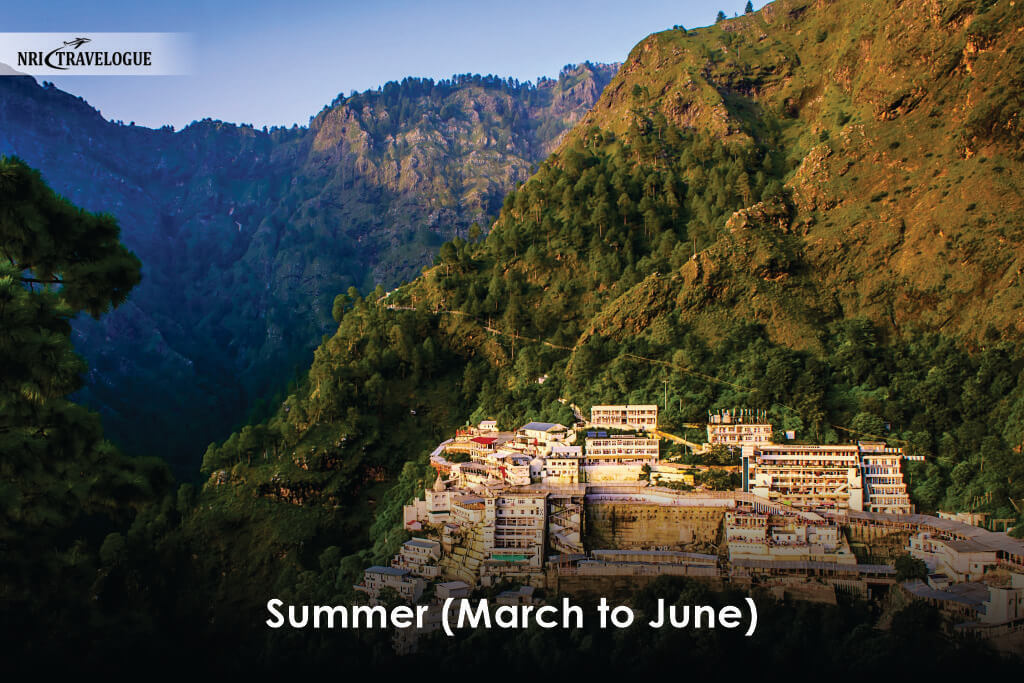When is the best time to visit Vaishno Devi? This is indeed an evident scenario that any pilgrim going on a pilgrimage to the holy site will ask. Located on Trikuta Hill in Jammu and Kashmir, the shrine of Vaishno Mata is one of the most famous pilgrim centers. The temple has yearly visitor traffic, which goes to millions. To get the most out of your visit to Vaishno Devi, it is important to understand the weather of Vaishno Devi, the festivals celebrated there, and the ideal time to plan your trip. This Vaishno Devi travel guide will clarify when it is best to travel and what a traveler can expect from the climate throughout the year.
Vaishno Devi Travel Guide: Overview
Vaishno Devi, one of the holiest temples in India, stands at an altitude of around 5,200 feet. It is devoted to Vaishno Devi, and many believers go on pilgrimage yearly. It is situated in the southwestern part of the country, in the Trikuta Mountains, near Katra in the states of Jammu and Kashmir. This temple is famous for its holy cave, which is a place where devotees can worship the goddess, represented by three naturally sculptured stones.
Best Time to Visit Vaishno Devi
The most crucial considerations that would assist in estimating the best time to visit Vaishno Devi are factors such as weather and crowd. Here, we discuss the climate by the season, informative festivals, and some tips when visiting the place.
Vaishno Devi Weather: Seasonal Breakdown
The climate of Vaishno Devi can be broadly described as having four different seasons: winter, summer, monsoon, and autumn. So, every season is equally good for the pilgrims to have a unique experience during their tour.
1. Winter (November to February)
It is recommended that you visit Vaishno Devi in the wintertime. The weather is cold, and many people don’t go there because of the cold.

It also gets colder with the low temperatures ranging between 2°C and 5 °C.
For December and January, there is snow, which gives the environment a very serene feeling.
They should wear warm clothing for the extreme cold weather that persists most of the year.
Pros:
- With less population, the experience is slightly less crowded.
- Snowy views are also a bonus in enhancing the beauty of the area.
- Less humidity and cooler temperatures.
Cons:
- Weather conditions, such as low temperatures, may lead to difficulty on the journey.
- Some services may be suspended, restricted, or slow during snowy weather.
2. Summer (March to June)
Pilgrims prefer visiting Vaishno Devi in the summer months as summer constitutes a major season for tourism. It is not very hot during the day; the average temperatures are normally between 15 and 30 degrees Celsius.

Trekking becomes possible throughout the year because of the favorable weather conditions.
Summer is also associated with several festivals, which draw crowds.
Pros:
- Comfortable temperatures for the trek.
- Larger concentrations of people help in creating a festive environment.
- Accessibility is relatively high during this period.
Cons:
- Increasing the percentage of the population that visits a particular site or coverage area translates to congested service delivery.
- The accommodation prices are relatively high because it is during peak season.
- More competition for services like transportation and meals.
3. Monsoon (July to September)
Moving onto the monsoon season, Vaishno Devi experiences moderate to heavy showers. This can make trekking more difficult, risky, and slippery.

The path can also get swampy, and the weather can also be wet sometimes, which ruins the experience.
Pros:
The landscape is equally stunning, with lush green and the effects of fog prevailing in the area.
Less crowded than some of the other parks, giving tourists a better view and experience of the park.
Cons:
Trekking difficulties or threat of landslides due to rain.
Not ideal for those who dislike humidity and wet conditions.
4. Autumn (October to November)
The climate of the Vaishno Devi can be enjoyed in the autumn, especially when the average temperature is between 10 °C and 20 °C. The climate is generally dry, with cool conditions, so it could be considered one of the best seasons to travel to Vaishno Devi.

There is a low chance of rain, and the way is plotted out.
Pros:
Comfortable temperatures for trekking.
Beautiful, clear skies with a calm atmosphere.
Fewer tourists than in the summer.
Cons:
It can be crowded around festivals.
This may cause accommodation rates to slightly increase during such periods of the year.
Vaishno Devi Festivals: Celebrations That Enhance the Pilgrimage
It is not only a religious place but also known as a place of celebrations where many fairs and festivals are organised. Such festivals make the spiritual trip more valuable and give a glimpse of the local culture.
1. Navratri Festival (September/October)
Navaratri is one of the biggest festivals, constituting nine days, which are celebrated to please the Goddess Durga. It draws thousands of people submitting their prayers and seeking blessings from the deity of gods and goddesses.

This is one of Vaishno Devi’s busiest periods because many pilgrims visit the shrine.
2. Makar Sankranti (January)
This festival refers to the beginning of the harvest season and is, therefore, very popular among the masses.

Devotees throng the shrine to offer their prayers to get the divine blessings of the Goddess to ensure success in all their endeavors.
3. Shivratri (February/March)
Another popular annual festival celebrated here is Shivratr, which is very energetic for those who book their darshan of Maa Vaishno Devi to seek the blessing of Lord Shiva.

It is also the time when pilgrims pray and fast in this period.
4. Baisakhi (April)
Baisakhi is normally associated with the harvest season and is a major festival of the Sikhs.

Also, it increases the crowd of pilgrims, which again contributes to the festive mood in Vaishno Devi.
How to Prepare for a Trip to Vaishno Devi?
A pilgrimage to the shrine of Vaishno Devi needs to be planned properly to ensure the trip is hitch-free and enjoyable.
Packing Tips:
- Clothing: Comfortable trekking shoes, woolen clothes for the winter trip, and cotton cloth for the summer trip.
- Health Essentials: Carry medications, a first-aid kit, and essential toiletries.
- Food & Water: Taking water and some snacks while trekking is recommended.
Trekking Preparation:
- Physical activity: Pilgrimage to Vaishno Devi shrine requires people to climb a 12 km steep ahead path. In particular, make sure you are in good health and fitness.
- Elevation: To avoid getting exhausted during the hike, make sure that you take intervals in between. Hydrate well throughout the journey.
How Long Does It Take to Trek to Vaishno Devi Temple?
The distance of the pilgrimage to the shrine of Vaishno Devi is estimated to be between 6 to 8 hours on foot, depending on the pace. It is like climbing a spiral staircase but full of spiritual benefits and gains. It is now easy for many pilgrims to choose the facility of helicopters or horses instead of walking the distance during the Vaishno Devi yatra walk.
Accommodations Near Vaishno Devi Temple
- There are several hotels, lodges, and guest houses to stay near Vaishno Devi temple. Among these are budget hotels, guest houses, and luxury rooms for those seeking comfort.
- Katra is the Largest town and center where most devotees have lodgement before they start their journey.
- The Vaishno Devi Shrine Board has also established other accommodation types, such as Dharamshalas, for those seeking affordable lodging.
What is the Best Way to Reach Vaishno Devi from Jammu?
The nearest airport of Vaishno Devi is in Jammu, India. For the Vaishno Devi pilgrimage, there are taxis, buses, and train services from Jammu to reach Katra, which is the Yatra base. Katra is well-connected to Jammu. The options for transport available are private taxis and shared jeeps.
- By Train: One can easily get a train to Katra from nearby places, including Jammu.
- By Road: Take a taxi or bus from Jammu to Katra.
- By Helicopter: Another way is by hiring a helicopter to travel to Sanjichhat from Katra, and then there is a small trek to the temple.
Final Words
To sum it up, there is no best time to visit Vaishno Devi; it all depends on one’s choice to prefer hot weather or cooler weather and preferred crowded places. On the other hand, various analyses of the temple and its surroundings during the winter and monsoon seasons might also be of considerable interest in terms of trekking. While visiting the Vaishnodevi Temple, it is always wise to consider the Vaishno Devi climate, local festivals, and other travel information. Irrespective of whether one plans his/her trip during the peak season to Vaishno Devi or to visit Vaishno Devi in the season, the journey is meant to be spiritually rewarding.
The best time to visit this place is summer because the mercury rises to very high levels throughout the year in the Rajasthan region. This place has a particularly attractive climate for tourists visiting it during the summer holidays.
This hike lasts for between 6 to 8 hours, depending on your physical strength.
There are several places to stay around the temple and include several accommodations which range from cheaper budget hotels to luxury rooms which are run by the Vaishno Devi Shrine Board.
It is important to note that one needs to pack accordingly, avoid dehydration, and look for lodging and transport services on the move.
To visit the temple one needs to travel either through taxi, buses, or trains to KATRA and then on foot for the trekking. For convenience, helicopter transport is also facilitated to some destinations.









